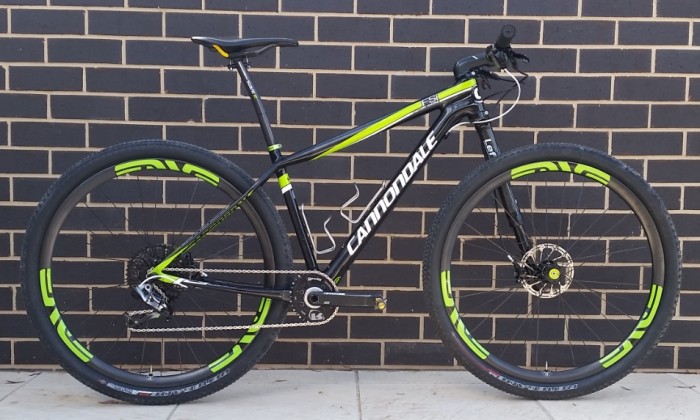Cannondale have a long history in the sport of mountain biking, especially in racing. Their F29 hardtail has been the choice of many marathon and stage racers due to the low weight of the frame and lefty, and the ride quality. It would be fair to say the Scalpel has never really met the demands of highly competitive racers, but again that comes down to the rider.
You can read a full bike check on James’ F-Si here
Cannondale sponsored Australian rider James Downing has been getting wheels drifting or off the ground on an F29 for countless seasons. He’s just received the new F-Si and was keen to share his thoughts about the frame re-design from Cannondale’s race thoroughbred.
“The F-Si is perfection in the steering department. The old F29er used to have a fair bit of understeer so you would have to work the front end a fair bit in order to keep your line, and occasionally it would run wide and you had to just cope. The F-Si corners like it is on rails. It is not overly twitchy but does have a very nice amount of front end twitch which is another way of saying that it steers and corners very easily.”
Cannondale have completely reworked the geometry of the bike, and the front end change is a big deal – especially for those who struggle to get low enough due to the constraints of the Lefty in the past.
“Obviously, the magic is in the offset of the fork axle, the slacker head angle and the reduced head tube length (from 134 to 97mm)”
The back end of the bike is also all new, aiming to tighten up the steering and increase the responsiveness. Getting the handling just right isn’t a set formula for 29er hard tails, but shorter backends help.
“The reduced length of the chainstays also helps a little with cornering, but also lends itself to sprinting (less flex), climbing (better rearward weight distribution). It also makes it easier when bunnyhopping logs. The larger wheels of most 29ers require longer chainstays. Coming from a 26er hardtail, I often battled the longer chainstay length coming up short on some bunnyhopping maneuvers. Not so on the F-Si. At 16.9 inches they are in the perfection range.”
The stays are short and the rear wheel sits nice and close.
“The wheelie balance point therefore, is also amazing. Coaster wheelies (wheelies without pedalling) are incredibly simple. Manuals (standing up non pedalling wheelies) are also easier, as the pivot point is easier to attain.”
Cannondales are often noticed most for the Lefty fork. It’s singlesided, stiff, and unique. But the new model is stiffer, helping keep handling on point.
“The new lefty ticks all the boxes. It has a larger diameter leg, which in turn is stiffer, which subsequently equates to more precise steering.”
The F29 was never critiques as a flexy bike, but some of the changes have made it stiffer. Downing points to the bottom bracket as helping with this.
“I also believe that the bottom bracket region feels like it is a little stiffer, but it also may just be the combination of the shorter stays and stiffer fork. The outcome is that sprinting feels a LOT more direct, with the power getting from the pedals to the rear wheel a lot better, with less flex and therefore loss of energy and power that the F29er displayed.”
There’s a lot more meat down there. And carbon.
“The bottom bracket height ‘feels’ lower also…which means better steering due to a lower centre of gravity. I’m not 100% sure that it is though….but it feels like it rides that way.”
So is it a perfect mix? When we spoke to Downing he’d only had 3 rides on the bike, and save for some of his usual customisations like a Q ring, Eggbeater pedals and his favourite tyres, he has a few other changes to make before it’s “perfect”.
“It ‘only’ has the XC29 ENVE hoops. The M50 wheels would be amazing on this rocketship! The rims being lighter would equate to a much snappier feel and even better acceleration! The grips are too large. Larger diameter grips increase hand fatigue.”
“All up though this thing is faster, it corners better and the fit for me personally is spot on thanks to the reduction in height of the steerer tube, than the outgoing F29er. I took it out on trails I know very well and rode them completely differently to how I did on the F29er. My cornering was a lot more precise, and by not having to fight the front end, I was able to be smoother and more efficient. That simply meant greater speed.”
We’ll catch up with Downing at Alice Springs next week four round two of the MTBA XCM Series, and see how his bike looks in race spec.

